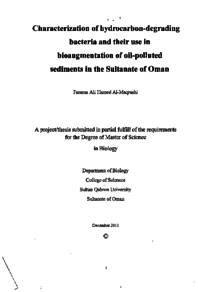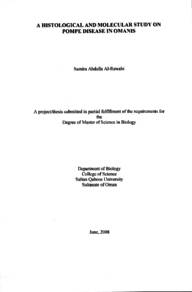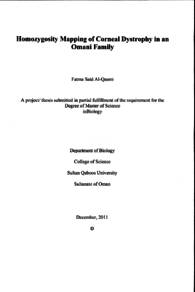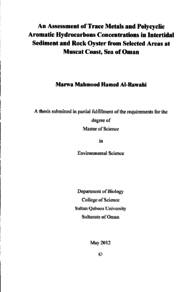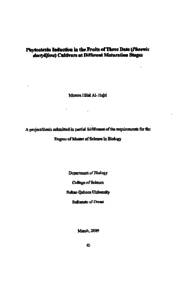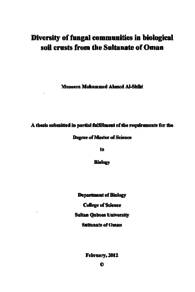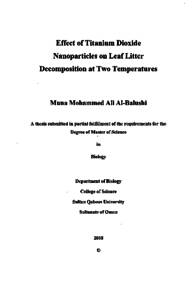Document
Characterization of hydrocarbon-degrading bacteria and their use in bioaugmentation of oil-polluted sediments in the Sultanate of Oman
Publisher
Sultan Qaboos University
Gregorian
2011
Language
English
English abstract
Oil spills could occur during oil production and transportation and many petroleum compounds contaminate the environment. These compounds are toxic to the environment and have to be cleaned. Bioremediation is the most environmentally friendly and cost effective method that can successfully remove contamination by converting oil completely to CO2. Bioremediation approaches such as bioaugmentation involving the addition of bacteria and biostimulation involving the addition of organic and inorganic nutrients have been widely used to clean up oil contamination. The research in this thesis aims at identifying 46 isolated oil degrading bacterial strains and testing their ability to degrade alkanes and to produce compounds that enhance biodegradation such as biosurfactants, biopolymers and fatty acids. A bacterial consortium out of these strains was designed and used to bioremediate two different oil-polluted sediments in the presence and absence of inorganic nutrients. Oil degradation was assessed by measuring the formation of CO2 and by comparing the concentrations of hydrocarbon compounds before and after the treatments using Gas Chromatography-Mass Spectrometry (GC-MS).
The 16S rRNA sequences of the cultured strains showed that they belonged to known oil-degrading bacterial genera such as Pseudomonas, Alcanivorax, Marinobacter and Halomonas. Biopolymer and biosurfactant production was assessed using Quarzviskosimeter and tensiometer, respectively and showed that none of the strains produced these compounds using acetate and sucrose as carbon sources. The strains had at least 6 fatty acids with hexadecanoate and its derivatives as the most dominant ones. Representative strains could grow much better on C13-C19 alkanes than C5-C7 alkanes. The best bioremediation efficiency was achieved by a combination of both bioaugmentation and biostimulation, where CO2 elevation was 6.73% and 9.58% for PDO and KH sediments, respectively. Hydrocarbon analysis showed a decrease in the treated samples, which means that degradation took place. We conclude that indigenous oil-degrading bacteria from Omani soils can be useful in the bioremediation of oil-polluted sediments in the region.
Member of
Resource URL
Arabic abstract
النفط هو أحد المكونات الطبيعية للبيئة والتي قد تحدث تلوثا في المحيط الخارجي والذي قد يضر بالكائنات الحية التي تعيش في البيئة المحيطة بما فيها الإنسان. مثل هذه المركبات تعد سامة ويجب تنظيفها من البيئة العديد من الطرق العلمية تستخدم لتحليل المركبات السامة مثل العلاج البيولوجي والذي يعتبر الحل الأمثل للبيئة والأكثلر فاعلية من حيث التكلفة؛ وذلك بسبب إمكانية إزالة التلوث بنجاح عن طريق تحويل الزيت تحويلا تاما إلى ثاني أكسيد الكربون. المعالجة الحيوية تشمل طرقا عدة بما فيها إضافة البكتيريا لتسريع التحليل النفطي (bioaugmentation) أو بإضافة المواد العضوية والغير عضوية كمواد محفزة (biostimulation). تهدف هذه الأطروحة إلى: تحديد انواع السلالات البكتيرية المعزولة على مركبات نفطية واختبار قدرتها على تحليل الألكانات. أيضا تختبر هذه البكتيريا من حيث قدرتها على إنتاج المركبات التي تعزز التحلل البيولوجي مثل biosurfactants، والبوليمرات الحيوية والأحماض الدهنية. تم اختيار كونسورتيوم جرثومي (consortium) مكون من 9 أصناف بكتيرية حيث تم استخدامه لتحليل نوعين مختلفين من التربة الملوثة برواسب النفط في حضور وغياب المواد الغذائية. لمعرفة مدى قابلية هذه الاستراتيجيات على تحليل النفط فقد جرى تقييم تحليل النفط عن طريق قياس تشكل CO2 وبمقارنة تركيزات المركبات الهيدروكربونية قبل وبعد العلاج باستخدام الغاز اللوني طيف الكتلة ( GC
- MS ). وأظهر تسلسل الحمض الأميني الريبوسومي (616) أن السلالات مقاربة لأنواع معزولة على النفط مثل البكتيريا الزائفة (
Marinobacter ، ( Alcanivora والمملوحات (Pseudomonas). كما تم البحث عن إمكانية إنتاج البوليمر الحيوي و.biosurfactants باستخدام Quarzyiskosimeter ومقياس التوتر السطحي على التوالي. وأظهرت النتائج أن هذه السلالات كانت غير قادرة على إنتاج هذه مثل المركبات عند استخدام خلات (peptone) والسكروز كمصدرين للكربون والنيروجين. على صعيد آخر فإن هذه السلالات كانت قادرة على انتاج ما لا يقل عن 6 من الأحماض الدهنية حيث كانت نسبة hexadecanoate ومشتقاته هي الأكثر هيمنة. عند اختبار قدرة السلالات المختارة على استخدام الكانات مختلفة كمصدر للطاقة وجدنا أن معظمها غير قادرة على استخدام الألكانات , C - C ؛ ولكن غالبيتها نمت جيدا على الألكانات ورC3 - C . عند قياس نسبة غاز ثاني أكسيد الكربون المنبعثة نتيجة تحليل النفط عن طريق البكتيريا وجدنا أن أفضل كفاءة للمعالجة البيولوجية تحققت بواسطة مزج الاثنين معا: الغذاء والبكتيريا؛ حيث كان أعلى مستوى الإنتاج غاز ثاني أكسيد الكربون الناتجة من رواسب الPD0 و KH بنسبة 6 . 3 % و ۹ . ۰۸ ٪ على التوالي. التحليل المباشر لبعض لألكانات المكونة للنفط أظهر انخفاضا في مستواها وقد تزامن مع نسبة ارتفاع غاز ثاني اكسيد الكربون؛ مما يعني أن تحليل النفط قد حدث فعلا. من هذا كله نستنتج أن المعالجة البيولوجية كانت طريقة ناجعة لحل مشكلة التلوث النفطي ضمن نطاق مصغر.
- MS ). وأظهر تسلسل الحمض الأميني الريبوسومي (616) أن السلالات مقاربة لأنواع معزولة على النفط مثل البكتيريا الزائفة (
Marinobacter ، ( Alcanivora والمملوحات (Pseudomonas). كما تم البحث عن إمكانية إنتاج البوليمر الحيوي و.biosurfactants باستخدام Quarzyiskosimeter ومقياس التوتر السطحي على التوالي. وأظهرت النتائج أن هذه السلالات كانت غير قادرة على إنتاج هذه مثل المركبات عند استخدام خلات (peptone) والسكروز كمصدرين للكربون والنيروجين. على صعيد آخر فإن هذه السلالات كانت قادرة على انتاج ما لا يقل عن 6 من الأحماض الدهنية حيث كانت نسبة hexadecanoate ومشتقاته هي الأكثر هيمنة. عند اختبار قدرة السلالات المختارة على استخدام الكانات مختلفة كمصدر للطاقة وجدنا أن معظمها غير قادرة على استخدام الألكانات , C - C ؛ ولكن غالبيتها نمت جيدا على الألكانات ورC3 - C . عند قياس نسبة غاز ثاني أكسيد الكربون المنبعثة نتيجة تحليل النفط عن طريق البكتيريا وجدنا أن أفضل كفاءة للمعالجة البيولوجية تحققت بواسطة مزج الاثنين معا: الغذاء والبكتيريا؛ حيث كان أعلى مستوى الإنتاج غاز ثاني أكسيد الكربون الناتجة من رواسب الPD0 و KH بنسبة 6 . 3 % و ۹ . ۰۸ ٪ على التوالي. التحليل المباشر لبعض لألكانات المكونة للنفط أظهر انخفاضا في مستواها وقد تزامن مع نسبة ارتفاع غاز ثاني اكسيد الكربون؛ مما يعني أن تحليل النفط قد حدث فعلا. من هذا كله نستنتج أن المعالجة البيولوجية كانت طريقة ناجعة لحل مشكلة التلوث النفطي ضمن نطاق مصغر.
Category
Theses and Dissertations

